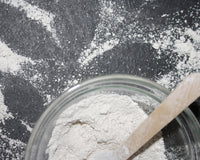Growing and maintaining both indoor and outdoor plants is a worthwhile activity that may provide a stress-relieving outlet and enjoyment. It forces you to take a moment and consider the needs of other living objects and also helps you get outside in the fresh air. Many plants are more than just decorative, offering various benefits when consumed or grown. Even if you don't have the outdoor space, or live in a less than sunny climate, improvements and developments in indoor grow lights can help you grow almost anything. Here are 9 plans that promote personal wellness that you can try growing in your home or apartment.
Peppermint
Peppermint is a popular herb that grows well in pots on patios or in the ground. Its leaves can be brewed in hot water and drank as a tea or used in a hot bath to help with respiratory discomfort. Another use for peppermint is its oil can be extracted to use in a variety of aromatherapy and flavoring applications that support the treatment of migraines, cramping, indigestion, and fatigue.
Hemp
Hemp plants are extracted to produce cannabidiol oil, otherwise known as CBD. This oil is used in topical applications such as lotions to help with pain relief and manage anxiety levels or regulate sleep. There are multiple versions of CBD oil and figuring out what is best for you can take some time and research. CBD oil used in vaping products may contain trace amounts of THC, the psychoactive component of marijuana.
Elderberry
Sambucus or elderberries are a type of shrub that is native to parts of North America and Europe. They can often be found growing wild in parts not too far off the beaten path. They can also be propagated and grown in containers for domestic use if foraging is not your forte. Elderberries contain high amounts of immune-boosting antioxidants that can strengthen your immune system against common viruses such as the cold or flu. You can juice the berries and add sugar to make a syrup or use the syrup to make treats such as nutrient-packed jellies.
Aloe Vera
Aloe vera is best known for helping to heal sunburns and moisturizing skin. It can also be blended into smoothies as a source of fiber or to help promote bowel regularity. It's a versatile succulent that can easily be grown indoors or in containers under the right conditions. Aloe vera plants like well-draining soil, bright light, and are very drought tolerant. To use aloe vera, cut off a piece of your plant, and carefully remove the skin. The inner jelly portion can be directly applied to burns, or used in creams, lotions, or shampoo.
Lavender
The subtle scent of lavender promotes a feeling of peace and tranquility. Lavender flowers can be harvested and dried into bouquets that will provide year-round aromatic sensations to various rooms in your house. You can consider hanging a bouquet in your bathroom, or in your bedroom near your pillow to help promote a good night's sleep. Lavender flowers are also a popular herb in various cuisines such as the famous Herbs de Provence chicken from France. You can also use it to freshen spaces such as your mudrooms or laundry rooms, as a simple but elegant decoration. Lavender may also act as a natural insect repellent to deter mosquitoes and other flying pests. Historically, lavender has even been used for its medicinal properties.
Spinach
Spinach can be easily grown from seed or from seedlings purchased at your local nursery. They thrive in partial shade conditions and can be either consumed raw in salads when young and tender, or grown to maturity and cooked in soups, sauces, or sautéed. Spinach is full of calcium, which can help strengthen bones, as well as vitamins, fiber, and folic acid. Spinach is thought to help protect against high blood pressure and heart disease.
Sansevieria
Also known as snake plants, sansevieria is a type of plant that can thrive in a variety of conditions. They originate from tropical destinations such as the south pacific or the jungles of Thailand, but have adapted to grow well in various indoor conditions even without supplemental lighting. They help purify your indoor air quality, which can often be worse than the air outside. They are extremely hardy and drought tolerant, requiring minimal care.
Pothos
Pothos or devil's ivy is a type of vining plant that is often used for indoor decoration. It can either be grown in soil or directly in water. If growing in water, find a dark-colored glass that will filter out most of the light to stifle algae growth. You'll also want to conduct regular water changes. Pothos plants are living artwork that grows easily. The vines can be managed to creep along walls adding stunning visuals to your home decor, possibly lifting your mood. It also helps improve indoor air quality to sustain your overall well being.
Broadleaf Plantain
Broadleaf plantain is a common type of weed found in gardens and yards. It's native to most of Europe and parts of Asia but has proliferated throughout most of the globe. While most will only see this plant as a weed, others will recognize it for its varied medicinal uses. Apply crushed leaves to open wounds to help reduce pain and protect against infection. The leaves can also be cooked and eaten and contain high levels of vitamins A, C, K, and calcium. The leaves can also be steeped in hot water to create an herbal tea to soothe sore throats and ease allergies. Before you apply weed and feed to your lawn, keep an eye out for this beneficial plant!
Plants do more than provide decoration to the background of our daily lives. They are great sources of natural nutrients that promote overall health and wellness to not only strengthen our bodies but also improve our state of mind. Adding beneficial plants to your landscaping or throughout your home can help improve your overall mood by merging natural elements with your environment. Routine maintenance, care, and watering of plants can also provide a relaxing routine.
For more wellness, healthy lifestyle, and exercise tips, check out more articles on the Wholefood Earth Blog.






